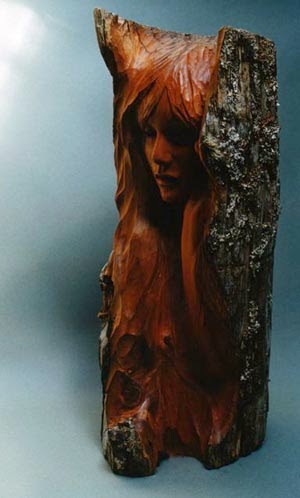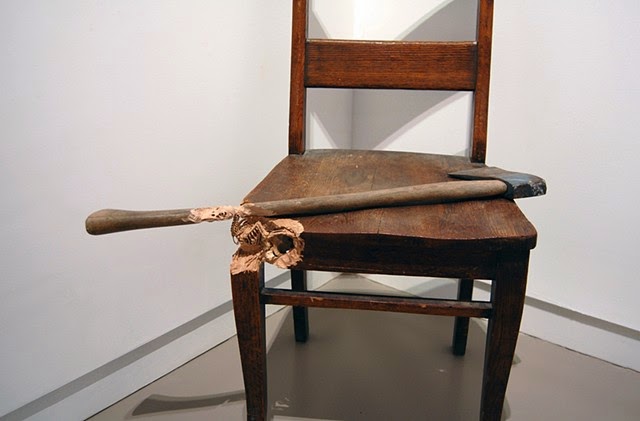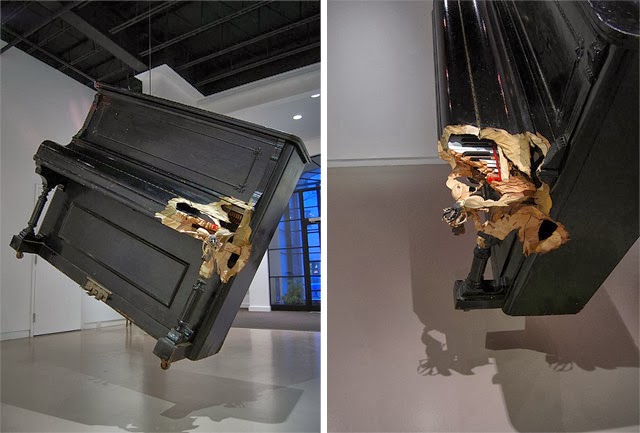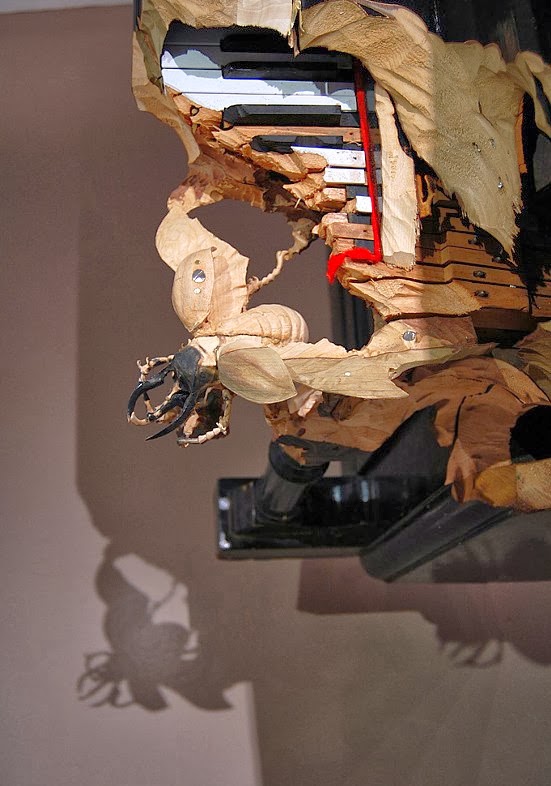One of the most charged moments in producing many carvings, particularly when whittling a shape from a piece of rough timber, is the moment when the sculpture is cut away from the piece of wood from which it has been carved. Sometimes I have been really torn as to whether I should take that step, as the sculpted piece looks so right against the uncarved timber that it emerges from.
Perhaps some of the most famous examples are the unfinished marble sculptures by Michelangelo known as the 'Prisoners'. These were carved between 1525 and 1530. The one below is sometimes called the 'Awakening Prisoner', sometimes the 'Awakening Slave':
Image from:http://www.freethought-forum.com/forum/showthread.php?t=11589&garpg=7
It's not certain whether Michelangelo stopped working on them because the building project that they were intended for was reduced in scale (the tomb of Pope Julius II, which was never completed to the original designs). That is the the usual interpretation, but I wonder if he just decided that the sculptures expressed what he was looking for and left them at that. Michelangelo saw himself as freeing the image created in a sculpture from within the confines of the uncarved block and that is certainly the feeling that these marble sculptures get across.
According to Rick Steves (mentioned in http://thosecrazyschuberts.com);
'Michelangelo believed the sculptor was a tool of God, not creating but simply revealing the powerful and beautiful figures he put in the marble. Michelangelo’s job was to chip away the excess, to reveal. He needed to be in tune with God’s will, and whenever the spirit came upon him, Michelangelo worked in a frenzy, often for days on end without sleep.'
Another sculptor who used the shape of the rough, unfinished block in their final sculptures was Auguste Rodin. This sculpture, produced in 1898, is 'The Hand of God', sometimes known as 'Creation' or as 'The Hand of the Devil':
Image from:http://bycommonconsent.com/2011/05/08/religious-art-the-hand-of-god/
Gilles Néret says that 'Though accused of making excessive use of the unworked surface, Rodin was again far ahead of his time; he appealed to the imagination rather than to the roles of sculptural convention.' It was certainly a controversial technique and ruffled the feathers of the nineteenth-century art establishment.
In common with a lot of famous sculptors, Rodin would have modelled the sculpture in clay and then one of his assistants would have carved it into the marble. However, Bernard Champigneulle wrote that his use of uncarved areas in the design was influenced by Rodin's initial career as a stonecutter. He would have understood the 'exhilaration' that came from 'the tussle between man and recalcitrant matter, with the removal of stone which could never be replaced, with the contest between a hand-held tool and an inanimate block from which life was about to spring.' On possible influences for this design technique, Champigneulle noted that 'Rodin's visit to the unfinished tombs of San Lorenzo (partly designed by Michelangelo for the Medici family in Florence) had taught him that to leave some areas unfinished could enhance the impact of others. Where Michelangelo had left marble untouched because time did not permit him to complete his task, Rodin did so deliberately. The delicacy of his modelling benefited by this contrast, which displayed the sculptor's skill to even greater advantage.'
Whilst chatting to Joachim Seitfudem (who carved the sculptures below), he noted that many traditional Bavarian limewood sculptures use the unworked surface of the log (with bark removed) to frame the carvings emerging from within. Jo's father is a master carver in Bavaria.
Giuseppe Penone is not specifically a woodcarver, but was one of the leading figures in the influential 'Arte Povera' movement that developed in Italy in about 1967. Artists associated with Arte Povera used inexpensive, often found, materials to make artworks. Penone was very interested in making sculptures that reconnected people to the natural environment and since the 1970's he has been making these sculptures, in which a growth ring inside a wooden beam is revealed by carefully cutting away the wood around it.
This reveals an echo of the tree at one point in its growth. In 'The 20th Century Art Book' published by Phaidon, each of these works is identified as 'an act of reclamation, an attempt to discover the natural shape of the tree within the man-made form.'
The resulting sculptures seem to me to share a lot in common with the others shown in this post and must be every bit as painstaking to produce. Sometimes, Penone would make the work in a gallery during the course of an exhibition.
Image: Sphilbrick from wikimedia.org
One piece of sculpture that really made an impression on me when I first saw it is 'Hinewai Calling from the Mist' by the New Zealand sculptor Paul Deans. The piece is carved from an old, found gatepost and illustrates a Maori legend about 'Uenuku and the Mist Girl', which you can read by clicking on this link to a previous post on this blog.
Image courtesy of Paul Deans
Apart from the great, dynamic use of contrast between the smoothly carved areas, areas of toolmarks and the rough, weathered original surface of the post, the way that the rough texture of the weathered timber is used to portray the thick mist around the face really appeals to me.
Maskull Laserre, who is based in Montreal, Canada, carves delicate forms emerging from everyday objects. I like the way that he will use more than one object put together to form the timbers into which he carves. Maskull works mainly with power tools to get these delicate sculptures. Personally, I'd prefer to see some of the carved skeletal shapes sculpted to a smoother, finer, more bone-like finish so that they would stand out more clearly from the tool marks in the timber around them. That doesn't take away from the fact that it's a great idea and these pieces are getting a lot of well-deserved attention at the moment.
http://www.thisiscolossal.com/2013/01/maskull-lasserre/
So, sometimes areas of a sculpture might be left uncarved as part of the story that the sculptor is trying to convey, sometimes those areas frame carved areas and sometimes those areas are just the result of the project being unfinished. The narrative and aesthetic tension that Rodin tried to convey, between carved and uncarved surfaces, still seems to be an important reason for carvers including this contrast in a design.
Perhaps another attraction for a carver is that the sculpture emerging from the block allows them to reveal another narrative, that of the work that went into producing such a carving, in a way that a completely finished sculpture might not show.
There is also something very compelling about seeing the carved work emerge from the block. It is like a glimpse of the making process, a way for the viewer to connect more closely with the hands of the maker.












